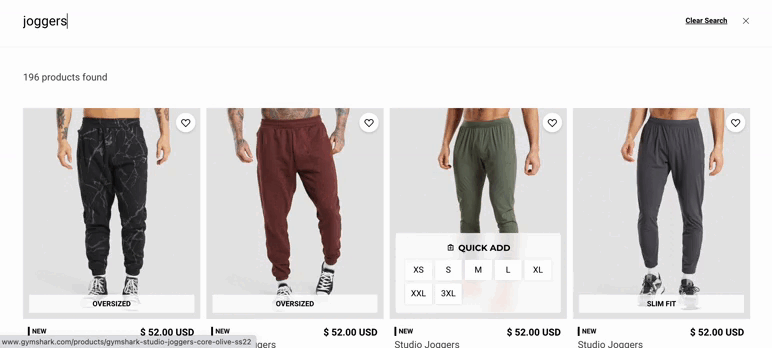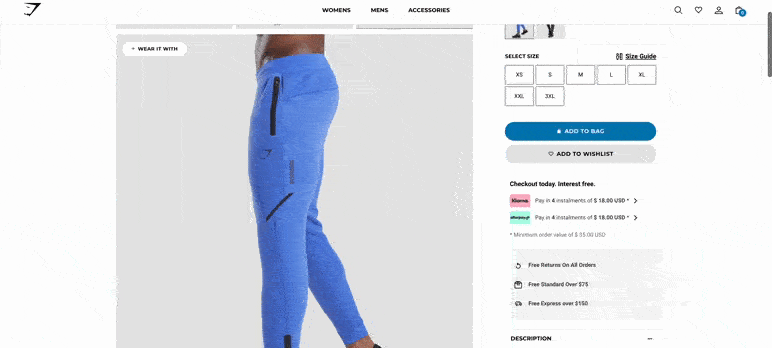Add InstantSearch and Autocomplete to your search experience in just 5 minutes
A good starting point for building a comprehensive search experience is a straightforward app template. When crafting your application’s ...
Senior Product Manager


A good starting point for building a comprehensive search experience is a straightforward app template. When crafting your application’s ...
Senior Product Manager

The inviting ecommerce website template that balances bright colors with plenty of white space. The stylized fonts for the headers ...
Search and Discovery writer

Imagine an online shopping experience designed to reflect your unique consumer needs and preferences — a digital world shaped completely around ...
Senior Digital Marketing Manager, SEO

Winter is here for those in the northern hemisphere, with thoughts drifting toward cozy blankets and mulled wine. But before ...
Sr. Developer Relations Engineer

What if there were a way to persuade shoppers who find your ecommerce site, ultimately making it to a product ...
Senior Digital Marketing Manager, SEO

This year a bunch of our engineers from our Sydney office attended GopherCon AU at University of Technology, Sydney, in ...
David Howden &
James Kozianski

Second only to personalization, conversational commerce has been a hot topic of conversation (pun intended) amongst retailers for the better ...
Principal, Klein4Retail

Algolia’s Recommend complements site search and discovery. As customers browse or search your site, dynamic recommendations encourage customers to ...
Frontend Engineer

Winter is coming, along with a bunch of houseguests. You want to replace your battered old sofa — after all, the ...
Search and Discovery writer

Search is a very complex problem Search is a complex problem that is hard to customize to a particular use ...
Co-founder & former CTO at Algolia

2%. That’s the average conversion rate for an online store. Unless you’re performing at Amazon’s promoted products ...
Senior Digital Marketing Manager, SEO

What’s a vector database? And how different is it than a regular-old traditional relational database? If you’re ...
Search and Discovery writer

How do you measure the success of a new feature? How do you test the impact? There are different ways ...
Senior Software Engineer

Algolia's advanced search capabilities pair seamlessly with iOS or Android Apps when using FlutterFlow. App development and search design ...
Sr. Developer Relations Engineer

In the midst of the Black Friday shopping frenzy, Algolia soared to new heights, setting new records and delivering an ...
Chief Executive Officer and Board Member at Algolia

When was your last online shopping trip, and how did it go? For consumers, it’s becoming arguably tougher to ...
Senior Digital Marketing Manager, SEO

Have you put your blood, sweat, and tears into perfecting your online store, only to see your conversion rates stuck ...
Senior Digital Marketing Manager, SEO

“Hello, how can I help you today?” This has to be the most tired, but nevertheless tried-and-true ...
Search and Discovery writer
For today’s retail consumer, search is not just about typing in queries. It’s about clicking on products, filtering on categories, and browsing through multiple product views, vivid layouts, promotional items, and customer reviews.
And now, it’s also about recommendations. Online retailers have learned the importance of recommending related, not just relevant products. They’ve learned that offering related products that fall outside of a query are nonetheless consistent with a consumer’s buying intent.
However, for recommendations to be successful, they must be meaningful – which can only come from a model-based, machine-learning recommender system. Luckily, retailers don’t need to know how to build those models themselves. Models and machine learning should come standard out of a search engine’s box.
Retailers should not need to do much to implement recommendations, except collect and analyze the right analytics and know how to display recommendations in the most effective way.
There are four elements to consider when getting started with recommendations:
Then what?
As already suggested, we expect a lot from a search bar. To be more precise, we want speed – search results need to appear instantaneously, preferably as we type. And we want relevance – the results need to be spot on.
But online businesses like Spotify, Airbnb, and Amazon don’t stop there. They’ve transformed the search bar into a comprehensive browsing, content management, and merchandising experience, cleverly named searchandising. Searchandising brings together a wealth of components like facets, category pages, multiple product views, carousels, banners, and much, much more – all of which multiply the onscreen options for the consumer.
However, in today’s explosive digital economy, even that is not enough. Leading online retailers have (machine) learned how to incorporate a powerful new dimension – recommendations. Recommendations allow online merchants to show its users, subscribers, and shoppers the products that complement and refine their current selection. A recommender engine is the final touch of an exhaustive, profitable search and discovery experience.
And there’s no turning back – any competitive online search and discovery platform must now include the capacity for both searchandising and recommendations. Our focus here is on recommendations.
A recommender system is not just an add-on to search. It’s a natural expansion of search relevance into a more robust sense of relatedness. As people search and interact online, it’s only natural that they be given all relevant information, including complimentary content, which, though not always matching their queries, is nonetheless deeply, meaningfully relevant to their buying intent.
Meaningful recommendations, when presented seamlessly to the consumer, not only increase revenue in unexpected ways, they can significantly shape a shopper’s buying choices. Consumers desire more options and are therefore happy to be guided to those options in a thoughtful way as they search.
Gymshark has seamlessly transformed an engaging search experience into a full discovery experience with recommendations. It begins with a query. In the below GIF, search results change as the user types a query. That’s always the first criteria, speed. The second criteria is relevance, which the user can confirm easily by seeing easy-to-read results, with images, titles, and prices, and a streamlined screen layout.

Next step is for the consumer to select one or more items to view. In this case, the consumer clicks on the blue joggers:

The design of the product view page encourages the consumer to scroll, where they see more photos, a video, and customer reviews. And at the bottom, the recommendations.

Note that Gymshark has thoughtfully added the recommendations to the bottom of these pages, to avoid distracting the user from viewing the product. After all, the goal of a product page is for the consumer to convert, not just continue shopping. However, maybe this is not the consumer’s desired product. At that point, they can use the search bar or back button – or, they can select a recommended item.
The consumer sees two sets of recommendations at the bottom of the page:


Recall:
Before getting into how all this works, let’s summarize the journey:
Why do recommendations work so well? There are several methods used to generate recommendations:
The most powerful recommendations come from user preferences. Learning user preferences helps the recommender system segment customers into profiles, allowing it to personalize its recommendations for each user.
Consumers indicate their preferences in several ways, for example, by clicking on specific items in the search results, adding an item to a cart, and of course, buying a product. As the system collects these preferences, it begins to discern patterns of relatedness, for example, which products do certain users view and buy together. Profiles come from combining these various preference signals (clicking, viewing, converting).
Capturing a large amount of click, view, and conversion activity can help the recommender machine create sharply-defined groups. For example, extreme sports enthusiasts perform significantly different activities (clicks, conversions, etc.) from bicyclists.
It’s called user-based collaborative filtering, because prior user behavior is aggregated and “collaborates” to form profiles for future users. The expectation is that the next customers will see recommendations based on profiles that are consistent with the actions they take.
A standard search-based feature is filtering, where users click on categories and facets to filter their search results. For example, if a Gymshark customer wants to see only blue joggers, they can filter the results by “color = blue” and “type = joggers”. Or they can filter by price or brand.
Filters can also be used to generate recommendations. Recommendations leverage filters in a similar way, by creating a network of related products and categories. For example, “type=joggers” can be set up as related-to “type=sport t-shirts”.
This is called content-based filtering, because the model uses the content, as opposed to user behavior, to determine the recommendations.
It’s worth mentioning that most systems combine the behavior-based and content-based models, to provide even more targeted, robust recommendations.
As a machine learns, by collecting more and more data, the business might also want to have some control over the recommendations. They usually do this with rules that push specific products under certain conditions. Here are some example use cases where it might make sense to manually override the automated recommendations:
With Algolia’s hosted Search and Recommender APIs, companies like Gymshark are empowered to offer their users a complete Search & Discovery journey, entirely unique to their business. Gymshark chose to add “You might like” and “Wear it with” recommendations, but other companies can come up with their own formulas that work for them. What will you come up with?
Powered by Algolia Recommend